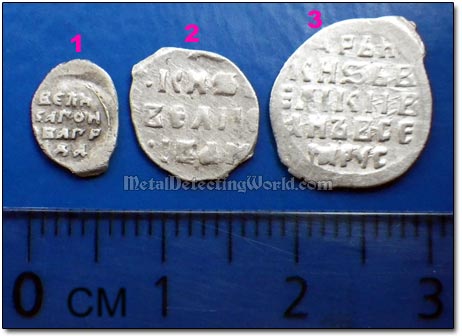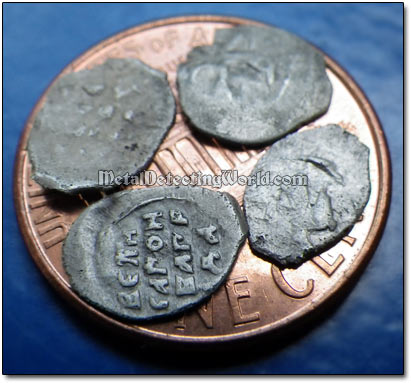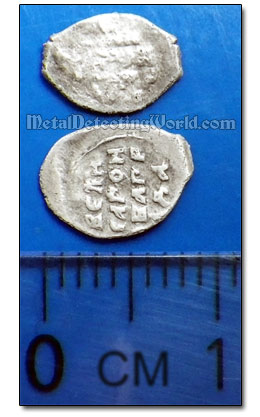Metal Detect Hammered Wire Coins
1. Brief Info on Early Russian Silver Hammered Coins - "Wire Money"
Production of so called "wire money" - coins made from silver wire, began in some Russian fiefdoms when the Golden Horde's control over occupied Russian territories began to weaken in the middle of the 14th century. From that point on, the wire coinage was the official currency in Russia until 1718.
A Few Representatives of Russian Silver Wire Coins

1. Polushka, unidentified;
2. Polushka, after 1538, Tsar Ivan IV Vasilievich, Novgorod mint;
3. Kopeck, circa 1696-1718, Tsar Peter The Great, Moscow mint;
4. Denga, circa before 1547, Tsar Ivan IV Vasilievich, Tver mint;
5. Kopeck, ca. after 1547, Tsar Ivan IV Vasilievich, Novgorod mint;
6. Denga (a large piece was broken off by a disc harrow), ca. 1420-1478, under the rule of Novgorod Republic, Novgorod mint;
Denga was the first face-value of wire money and had a weight of about a gram. In 1350, production of Dengas ("moskovkas") as hammered coins began only in the southern Russian principalities, with the state of Novgorod and the City of Pskov producing their own slightly larger coins ("novgorodkas"). In their earliest form, Dengas were imitations of the silver coinage of the Golden Horde's Khans, usually bearing blundered or meaningless legends.
From the time of the Prince Dmitry Donskoy (1362-1389) onwards, the coins began to take a more Russian form, with depictions of people and animals, and legends inscribed in the Old-Russian script, although the presence of legends partly in Arabic (the language of the Horde) persisted on some coins until the time of the Czar Ivan III Vasiljevich (1462-1505). From 1462 onwards, the wire money coins had only the image of a horseman on the obverse. On the reverse, the wire hammereds bore the legend - Czar's name and his titles, which was often partly cut off.
Before a monetary reform of 1535 (during the rule of underage Ivan The Terrible), the Early Russian wire money varied in denominations and coin weights. When the monetary reform took place, and unification of Russian coins began, the northern "novgorodka" was valued at twice the southern Denga or "moskovka". The production of novgorodkas as standard hammered silver coins depicting a horseman with a spear began nationwide. The "novgorodka" coin was henceforth known as Kopek, Kopeck, Copeck, or Kopeyka (in Russian: Копейка), its name derived from the Russian word "kop'yo" ("Копье") — a spear. At their widest, Kopecks were only about 15 millimeters.
From the 1540s onwards, the horseman began bearing a crown which represented Ivan the Terrible who was titled "Grand Prince of all Russia" prior to 1547 and "Czar" (or "Tsar") thereafter. Thus the crown became and had remained a required attribute of all subsequent Russian tsars depicted on the wire coinage.
Besides the Kopeck denomination, two smaller coin denominations, Polushka (#1 and #2 on a picture above, and #1 on a picture below) and Denga (#4 on a picture above, and #2 on a picture below), were standardized under the 1535 reform. In accordance with the monetary system of that and the subsequent periods in Russian history, 1 Kopeck = 2 Denga's = 4 Polushka's; their weights relating accordingly: 0.68g, 0.34g, and 0.17g (from 1533 to 1584). And from 1535 to the present, 100 Kopecks = 1 Rouble.
Reverses of Polushka (#1), Denga (#2), and Kopeck (#3) of Czar Ivan IV The Terrible

Bringing these exact coin denominations into circulation was required by increasing commerse between Russia and the Western-European sovereigns. When the Denga coins sometimes were too large in value for smaller transactions, the Polushka coins served the purpose as well as equalled to the smallest European coins.
For metaldetectorists in the West to see how tiny the silver polushkas are, I took this picture of four Polushka coins that easily fit on a U.S. penny.

Diversity of the Early Russian wire coins that were hammered between the late 14th century and the early 18th century is enormous: there are really THOUSANDS of varieties in existence! So if you plan to get into wire-money hunting and/or wire money collecting, you should obtain special wire-coin catalogues to be able to distinguish between different types of hammereds and know what you find.

During fine-tuning your metal detector for the wire-coin shooting, for example, the Polushka coin, circa 16th century, should be used as a "model" during optimization of the search program settings. Weighing 0.17g (the weight of this coin denomination fell to 0.1g by 1682) and measuring 6.5mm x 8.5mm, or smaller, as shown on the image to the left, the Polushka coin is the most challenging target even for an experienced metaldetectorist. If your metal detector can "see" the Polushka, all other wire-coin denominations will sure be detected. However, metal detectors of some brands cannot "see" this tiny coin in the ground at all.
Even though the silver content of the early 16th century wire coins is high ("960" milessimal fineness), the metal detectors with factory-preset Multi Tone ID do not respond to these coins with high-pitched tones like they usually respond to "normal" silver coins of high silver content. For example, the Minelab E-Trac's audio response to the Polushka has such a low tone pitch that it can be easily confused with an audio response to a piece of foil.
The pitch tone of audio response to the Denga coins is a bit higher. This is why the Multi-Tone Audio mode is the best to use in order to hear slight differences between signals in the low-tone range. If a metal detector with adjustable tone frequencies is used, a single high-pitched tone is usually assigned to the entire conductivity range of the hammered wire coins while lower pitch tones are assigned to other categories of targets.
Because these hammereds have irregular shape (one can hardly find a perfectly round hammered coin of this type), some coins may sound off with an "ambiguous" or inconsistent signal that must be investigated for sure. What makes it difficult, sometimes almost impossible, to recover the detected wire coins is their specific characteristic - they are likely to be undetectable after having been removed from the ground and ending up in a pile of dug dirt. Special recovery techniques must be used (see details in my article My Recovery Techniques for Retrieving Single Hammered Wire Coins).
By the end of the wire coinage production in Russia in 1718, both the weight and size of Kopeck coin had dropped so dramatically, due to the continuous coin debasement, that the 18th century Kopeck coin (coin #3 on the first picture above) looks very close in size to the polushka coin (coin #2 on the same picture) of the 16th century in comparison.
The area of circulation of the Early Russian coinage included modern Eastern Europe, North-Western and Central Russia, and Southern Scandinavia. The counterfeit Russian wire coins were also hammered at the Swedish, Dutch and English mints in the 17th century. The area of circulation of prototypes of the Russian wire money - the hammered silver coins of the Golden Horde, stretched much wider in the 12th-14th centuries, and covered modern Southern European and Asian Russia, Ukraine, states in Central and Northern Asian territories, and areas in the Middle East.
Back to Detect Hammered Coins Index page